
Add the General description for teachers to see. And resource added in the "Add Resource" will be for the teacher only.
- Subject:
- Educational Technology
- Material Type:
- Lesson Plan
- Author:
- Denise Krefting
- Date Added:
- 03/16/2017

Add the General description for teachers to see. And resource added in the "Add Resource" will be for the teacher only.

Guiding Question: In what ways do “single stories” impact our own identities, how we view others, and the choices we make?
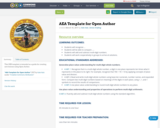
This OER template is intended as a guide for creating new lessons using Open Author.
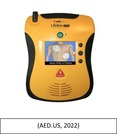
This course provides an introduction to the use of an automated external defibrillator (AED), and is primarily intended for healthcare workers in a community hospital setting. This short course is intended to discuss the basic uses of the Defibtech Lifeline AED. However, there is a similarity to other AEDs, which could be carried over into those devices. This short course is intended to discuss the basic uses of the new AED. There will be a future offering of the more advanced features, such as the electrocardiogram (ECG), available soon. The course is preferably instructor lead; however, it can be accomplished solo by the learner as well.
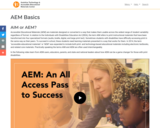
AIM or AEM?
Accessible Educational Materials (AEM) are materials designed or converted in a way that makes them usable across the widest range of student variability regardless of format. In relation to the Individuals with Disabilities Education Act (IDEA), the term AIM refers to print instructional materials that have been transformed into four specialized formats (audio, braille, digital, and large print text). Sometimes students with disabilities have difficulty accessing print in the same way as their peers. To succeed in school, these students need learning materials presented in a way that works for them. In 2014, the term "accessible educational materials" or "AEM" was expanded to include both print- and technology-based educational materials including electronic textbooks, and related core materials. Practically speaking the terms AIM and AEM are often used interchangeably.
In the following video learn from AEM users, educators, parents, and state and national leaders about how AEM can be a game changer for those with print disabilities.
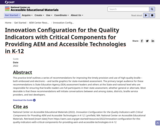
This practice brief outlines a series of recommendations for improving the timely provision and use of high-quality braille – both embossed and electronic – and tactile graphics for state-mandated assessment. The primary target audience for these recommendations is State Education Agency (SEA) assessment leaders and others at the State-and national level who are responsible for ensuring that braille readers are full participants in their state assessment, whether general or alternate. Most desirable is that these recommendations will initiate conversations between and among states, districts, braille service providers, and test developers.
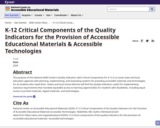
The purpose of the National AEM Center’s Quality Indicators with Critical Components for K-12 is to assist state and local education agencies with planning, implementing, and evaluating systems for providing accessible materials and technologies for all students who need them. States and local school districts will find the Quality Indicators useful for implementing statutory requirements that mandate equitable access to learning opportunities for students with disabilities, including equal access to printed materials, digital materials, and technologies.
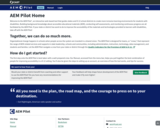
AEM Pilot Home
Welcome to the AEM Pilot*, an interactive web-based tool that guides states and K-12 school districts to create more inclusive learning environments for students with disabilities. Building background knowledge about accessible educational materials (AEM), conducting self-assessments, and monitoring continuous progress are all facilitated by the AEM Pilot. If your state or district has work to do to improve the accessibility of the materials and technologies provided to learners with disabilities, take off with the AEM Pilot!
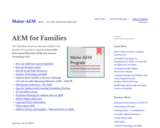
AEM for Families
Accessible Educational Materials: The following resources will assist students and families with questions regarding Accessible Educational Materials (AEM) and Assistive Technology (AT):

Accessible Educational Materials (AEM) help students with disabilities access print- and technology-based materials in school. But what about accessing educational materials in the community? Learn about AEM in the community: where you might find it, what it can look like, what to do if community materials are not accessible, and how to equip and advocate for yourself or those you support. In addition, hear what Community Vision is doing to help make businesses, organizations, and public spaces more accessible. They also share a few resources they have created around accessibility.

Welcome to the first, biannual Archival Educators Roundtable (AER) Newsletter! In 2016, the Rockefeller Archive Center (RAC) brought together like-minded professionals who use primary sources for public programming, outreach, and education, and the AER was born. As archival education is a still-developing field, the AER created a community where people could share their successes, challenges, and works in progress through casual workshops.AER’s network of educators, archivists, and archival education allies has since expanded its culture of support beyond the biannual meetings here at the RAC through social media, event attendance, joint publications, and email correspondence.It is our hope that this AER Newsletter will further extend the table, so speak, reaching more colleagues as we spotlight educators, and showcase the projects, challenges, and successes of archival education. Just as the aim of AER meetings is to ensure that all perspectives on primary source education are honored, we encourage you, our dedicated AER audience, to reach out and contribute your insights to future AER Newsletters! Many thanks to our first issue's contributors--we couldn't have done it without you.--Marissa Vassari, Archivist and Educator, Rockefeller Archive CenterElizabeth Berkowitz, Outreach Program Manager, Rockefeller Archive Center
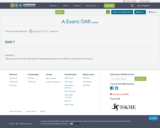
This resource describes the plan for implementing the use of OERs in our elementary school.

Should A+ Certification Exam candidates use brain dump sites? My answer, might surprise you.
This is part of Mr. Ford's Guide to the A+ Certification Exam: How to Be A Computer Technician.

These tools are designed to assess various dimensions of affect, including positive and negative emotions, emotional intensity, and emotional stability.

Affective evaluation is a type of student assessment that focuses on traits such as motivation, attitude toward learning, and emotions of self-efficacy.

Affective assessment plays a crucial role in capturing and understanding individuals' emotions, attitudes, values, and social-emotional skills. It supports the development of a learner-centered approach and enables educators and practitioners to tailor interventions, provide targeted support, and create environments that foster emotional well-being and positive learning experiences.

Affective assessment is a method used to evaluate individuals' emotional, social, and attitudinal aspects. It involves measuring and analyzing subjective experiences, attitudes, and feelings, providing insights into one's affective states and their impact on learning, behavior, and well-being.

This module aims to assess students' perception of positive school culture through an affective survey. The survey will be conducted using a Likert scale, allowing students to provide their responses on a spectrum of agreement or disagreement. This module not only focuses on administering the survey but also provides guidance on interpreting the survey results and offers strategies for addressing any identified areas for improvement in the school culture.Module Content:1. Administering the Affective Survey: 2. Interpreting the Survey Results:

AFFECTIVE ASSESSMENT DESIGN PLAN

This presents a work about affective authentic-based assessment, a methodology that focuses on evaluating learners' affective and authentic dimensions within educational contexts. The assessment approach combines authentic tasks and self-report measures to capture learners' emotions, attitudes, values, and beliefs